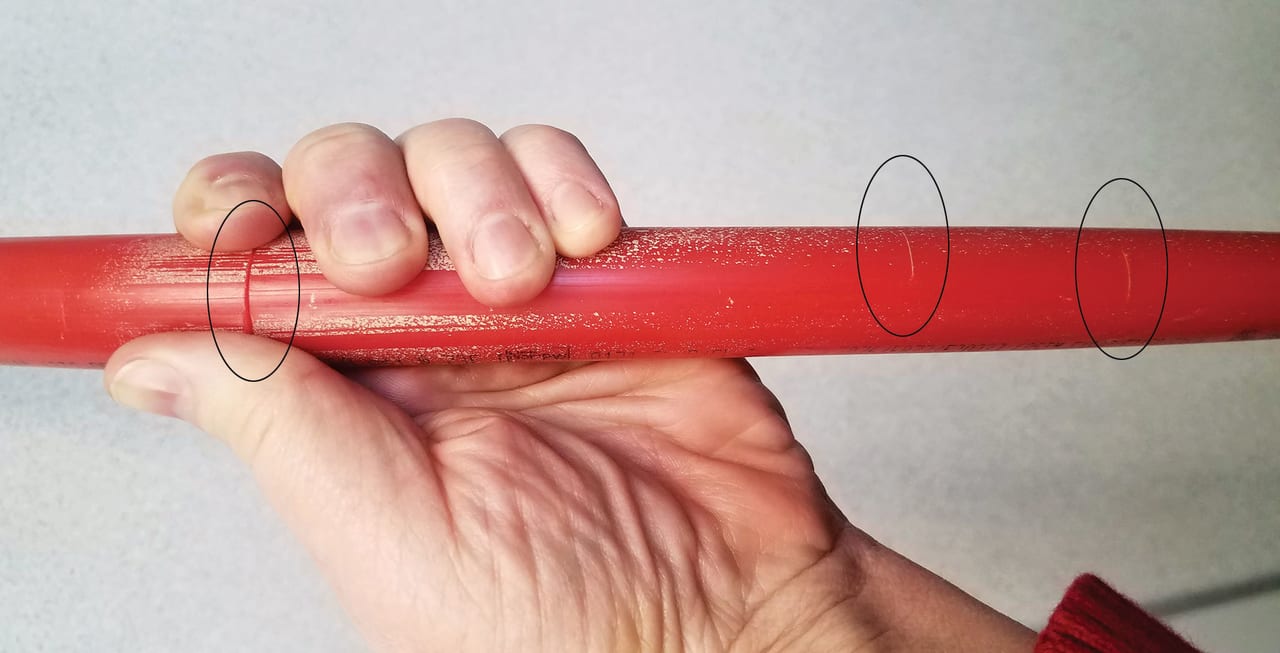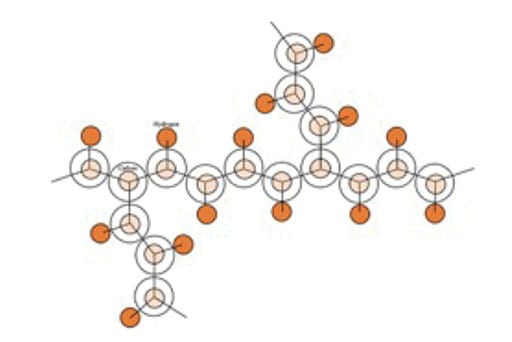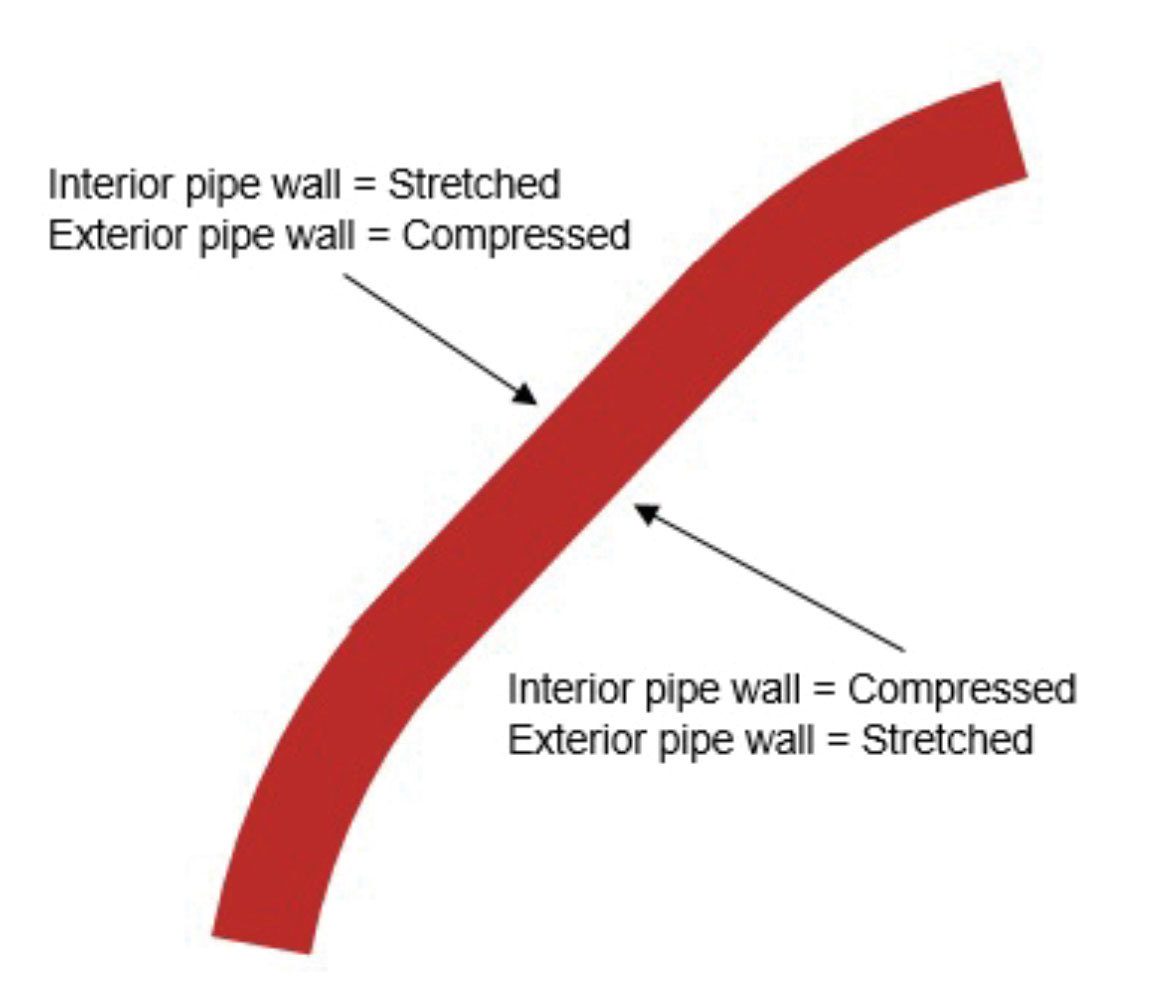Basement renovation caption for radiant flooring in progress.
Don’t flex your PEX
Recent advancements uncover a previously unidentified cause of early PEX failure.
By Jonathan Simon
Since its introduction in the United States, cross-linked polyethylene (PEX) has become an extremely common product in residential and light commercial plumbing piping applications. The key reason for the rapid adoption of PEX piping is the material’s flexible nature. Being sold in coils of several hundred feet and installed using sweeping bends significantly reduces the need for couplings and elbows. However, this flexibility may also be the proximate cause of piping failures that are starting to appear across the country.
Background
PEX is not the first flexible plastic plumbing system to be used in the United States. In the 1970s, another material called polybutylene was introduced and rapidly gained market share thanks to its innovative installation methods. However, by the mid-1980s, polybutylene’s greatest weakness had been exposed, as the material suffered widespread failures due to oxidative degradation caused by the chlorinated water flowing through it. These failures ultimately resulted in a major class-action lawsuit (Cox vs. Shell) that culminated in the single largest building product defect settlement in U.S. history.

FIGURE 1
PEX failure resulting from a combination of mechanical stress from bending and chlorine degradation.

FIGURE 2
Through-wall crack, from interior (magnified).


FIGURE 3
FIGURE 4
Figure 3: Polybutylene molecule.
Figure 4: Cross-linked Polyethylene (PEX) molecule.
Polybutylene's vulnerability to chlorine was due to its molecular structure as a polyolefin plastic, which exposes the carbon chain to attack from chlorine-based water disinfectants. However, even while polybutylene was being removed from American plumbing codes, another polyolefin plastic was being introduced – PEX.
Recognizing the shared vulnerability of PEX and polybutylene polymers to oxidative degradation in chlorinated water, new ASTM standard was developed to “evaluate the long-term, chlorinated water, oxidative resistance of PEX” using the procedures developed to evaluate pipes manufactured from polybutylene. In September 2000, this standard, ASTM F2023, was first published. While this standard is designed to test and extrapolate a lifespan of PEX systems, the standard itself states that “the extrapolated values do not constitute a representation that a PEX tube or system with a given extrapolated time-to-failure value will perform for that period of time under actual use conditions.”
Indeed, there have been many reported incidents of oxidative degradation failures in PEX tubing under actual use conditions.
Documented use conditions beyond ASTM F2023
Not long after PEX usage became relatively common, failures caused by oxidative degradation began to arise. These chlorine-induced oxidative degradation failures can largely be attributed to a short list of reasonably common operating conditions which are not covered by the scope of ASTM F2023. These conditions include:
- UV exposure beyond the rated limits;
- Antioxidant migration into attached products (i.e., tape, insulation);
- Temperatures exceeding 140° F;
- Water pressure exceeding 80 psig; and
- Water with an oxidative reduction potential >825mV.
Each of these conditions can significantly accelerate the rate of oxidative degradation, resulting in what ASTM F2023 calls a “stage 3 failure” or a pure oxidative failure characterized by multiple through-wall cracks.

FIGURE 5
Stage 3 PEX failure from a system reported to experience intermittent water pressure spikes above 80psig in chlorinated water.
Failure modes not covered by ASTM F2023
While these stage 3 failures are explainable exceptions to the extrapolated time-to-failure based on the documented limitations of ASTM F2023, the circumferential cracking shown in Figure 1 is an example of a “stage 2” or brittle failure that cannot be explained by the previously mentioned factors. It is important to note that ASTM F2023 does not consider any data on stage 2 failures.
Since the intent of the standard is to extrapolate a time-to-failure in chlorinated water based on stage 3 data, any stage 2 failures that occur during testing are simply thrown out and not considered for the test analysis. This is unfortunate because there have been incidents of stage 2 PEX failures in the field which appear to be related to oxidative degradation. In the example shown in Figure 1, a 3/4-inch section of PEX-b tubing experienced multiple circumferential through-wall cracks on the hot water side after approximately 10-12 years in service in a home in California. Analysis of the failure found a degraded layer between 50-100 microns thick, which is less than one-tenth of 1% of the thickness of the 3/4-inch PEX pipe. Based on this depth of degradation after 10-12 years, it is reasonable to extrapolate that the pipe should have remained in service without experiencing a stage 3 failure for many years, likely exceeding the 50-year expectation. So why did the pipe fail?

FIGURE 6
Degraded layer of PEX piping approximately 50-100 microns thick after 10-12 years in service.
Forensic analysis of the failure suggests that the through-wall crack is the result of stress-corrosion cracking which began in the thin embrittled layer that had been degraded by the chlorinated water, and then propagated via slow crack growth under mechanical stress caused by flexing of the pipe. This is understood to be the reason the cracks developed circumferentially rather than longitudinally. Yet, because the cracking originated on the interior wall of the pipe on the outer radius of a curve, the mechanical stress in the original crack location should have been in compression, which would be an unlikely location for a crack to form. What mechanism could have created stretching forces where the pipe should have been under compression?
PEX manufacturing methods and tension dynamics
There are three primary methods of producing PEX piping; for the purpose of this discussion, PEX-a and PEX-c use a similar process:
- In PEX-a and PEX-c manufacturing, the polyethylene is cross-linked during extrusion, which locks the natural state of the piping in a straight-length configuration; and
- PEX-b is crosslinked after extrusion while coiled. This can lock in the natural state of the PEX-b in a coiled position.


FIGURE 7
FIGURE 8
Figure 7: Mechanical stress from bending a straight pipe (PEX-a and PEX-c).
Figure 8: Mechanical stress from straightening a bent pipe (PEX-b).
When any piping, including PEX piping, is bent into a configuration other than its locked-in natural state, it places the pipe under mechanical stress. As shown in Figures 7 and 8, if the pipe’s natural state is coiled, then straightening the pipe or bending it in the opposite direction of its initial coil will induce stress; if the pipe’s natural state is straight, then bending it will induce stress. When the interior pipe wall is stretched, it creates a vulnerable point where a thin oxidized layer can crack and then propagate through the wall to create a pinhole leak.
Risk of visual misdiagnosis
Because this failure mode results in circumferential failures and typically occurs in a section of pipe under some form of tension, either from bending or straightening against the natural state of the pipe, it can be easy to misdiagnose the cause of failure upon visual inspection.

FIGURE 9
Exterior view of circumferential cracking resulting from a combination of mechanical stress from bending and chlorine-induced degradation.
As shown in Figure 9, the exterior surface of the crack visually appears to be the result of external damage. Indeed, this failure and other similar failures have reportedly been visually diagnosed as the result of a number of external physical sources ranging from vibration or rubbing of the pipe against a structural member to pipe that was nicked with a cutting tool or other blade during or after installation. Without a more thorough, scientific evaluation of the failures, it would be nearly impossible for a plumbing contractor or homeowner to tell the difference between physical damage and this form of chlorine-induced stage 2 failure. It’s impossible to tell how many of these failures have occurred in the field and been mistakenly dismissed as installer errors. Based on the typical, low degree of degradation found in this failure, it would be reasonable to assume levels of degradation similar to those found in Figure 6 exist in PEX piping across hundreds of thousands of homes across the United States. The large usage in homes across the U.S., combined with the frequency at which PEX is installed bent outside of its natural state, suggests that this failure mechanism may be surprisingly common.
Conclusions
The single greatest advantage of PEX pipe — its flexibility — may well be its greatest vulnerability. While stage 3 chlorine-induced oxidative degradation failures have occurred in PEX plumbing systems when the operating limits of ASTM F2023 are exceeded, these failures are largely dependent on the combination of variables — such as temperature, pressure, water quality and UV exposure, which can be inconsistent from location to location — leading to sporadic failures in individual homes or geographic pockets with similar conditions.
Now, with the discovery of this new failure mode, the risk of chlorine-induced stage 2 failures in physically stressed pipes could be present nationwide. A thin oxidized layer is expected on the interior pipe wall of all PEX systems that have been exposed to chlorinated water and would not generally be considered unusual or a risk factor for premature failure when used within specified operating parameters. But when you add the mechanical stress of bent pipe, each of these systems may be at risk. When an already stressed PEX pipe is degraded, the risk of stress corrosion cracking is lower because the stress is considered static; however when an already typically degraded PEX pipe is subjected to new bending stress — whether from thermal expansion and contraction or physical manipulation — the risk of cracking is significantly higher.
Because of this, it is advisable that plumbing contractors should avoid “flexing their PEX” —meaning both bending pipe that was cross-linked while straight or straightening pipe that was cross-linked in a coil. In either case, the act of bending the PEX pipe may put the system at risk of accelerated failure.

Smitt/iStock / Getty Images Plus via Getty Images. Figures courtesy of Lubrizol Advanced Materials Inc.
Jonathan Simon is the North American residential plumbing manager for Lubrizol Advanced Materials Inc., the parent company for FlowGuard Gold Pipe and Fittings. For 60 years, FlowGuard Gold Pipe and Fittings has provided reliable hot and cold water plumbing systems to residential and commercial buildings.
